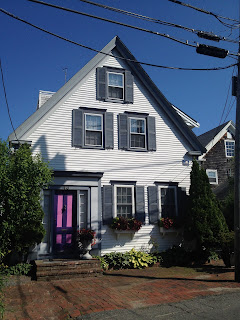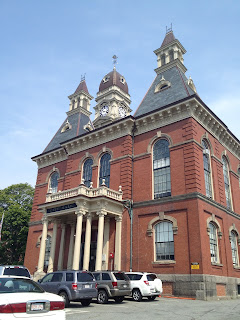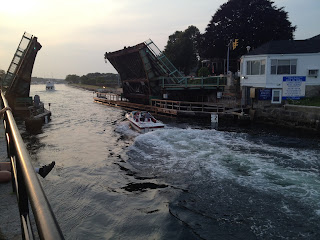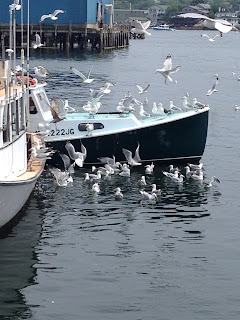
While in Gloucester (Glosta), the most fun we had was touring the Cape Pond Ice Company. Scott Memhard, "the coolest guy around" and owner of the historic ice house showed us the operation. The tour started with a short film on the history and importance of ice followed by clips from the movie
A Perfect Storm that featured Cape Pond.
"Commercial fishing simply wouldn’t be possible without ice. Without diesel engines, maybe; without loran, weather faxes, or hydraulic winches; but not without ice. There is simply no other way to get fresh fish to market. In the old days, Grand Banks fishermen used to run to Newfoundland to salt-dry their catch before heading home, but the coming of the railroads in the 1840s changed all that. Suddenly food could be moved faster than it would spoil, and ice companies sprang up practically overnight to accommodate the new market. They cut ice from ponds in the winter, packed it in sawdust and then sold it to schooners in the summer months. Properly-packed ice lasted so long -- and was so valuable - that traders could ship it to India and still make a profit...
Fishing boats still make the same mad dashes for shore they were making 150 years ago, and the smaller boats -- the ones that don’t have machines-- are still buying it in bulk from Cape Pond Ice, located in a low brick building between Felicia Oil and Parisi Seafoods. In the old days, Cape Pond Ice used to hire men to carve up a local pond with huge ice-saws, but now the ice is made in row upon row of 350-pound blocks, called ”cans.” The cans look like huge versions of the trays in people’s refrigerators. They’re extracted from freezers in the floor, skidded onto elevators, hoisted to the third floor, and dragged down a runway by men wielding huge steel hooks; the men work in a building-sized refrigerator and wear shirts that say, “Cape Pond Ice - The Coolest Guys Around.” The blocks are shoved down a chute into a steel cutting drum, where they jump and rattle in terrible spasms until all 350 pounds have been eaten down to little chips and sprayed through a hose into the hold of a commercial boat outside.”
From “The Perfect Storm” by Sebastian Junger.
 |
| A room of "ice trays' covered with plywood. |
 |
| Each block will weigh 300-350#. Up to 150 tons of ice is produced each day. |
 |
| Chilled brine is pumped around the room/cans to freeze the blocks. |
 |
| To make clear ice, for sculptures or parties, a mechanical metal rod is placed in each can and moves up and down during the freezing process. |
If it's not clear ice, it's feather ice.
 |
| Scott explaining the operation. |
 |
| Elevator to the upper floor. |
 |
| Blocks waiting to be crushed and sold. |
Pallets of 30#, 40# and 5# bagged ice are shipped around Cape Ann and New England.
 |
| Since 1848, years of wear on the wooden floor. |
Cape Pond produces bag ice, block ice, bulk ice, dry ice, ice sculptures and blocks, ice luges!, cocktail ice, and concrete ice. Yes, concrete ice. They provide ice to construction sites, including the Big Dig in Boston, to help cool and cure the concrete.
 |
| This "old man and the sea" sculpture was made 18 years ago. Still hanging around. |
 |
| Various ice sculptures. |
Fishing vessels pulling up to the company wharf take anywhere from 300# to 30 tons of ice per fishing trip. Cape Pond Ice can pump at 1 ton/minute on up to three vessels at a time.
Thanks Scott for a wonderful tour.
Cape Pond Ice









































































